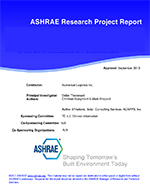Description
Water-side fouling is an operational problem and must be controlled to maintain design performance for a condenser. In addition, fouling on augmented tubes imposes an additional uncertainty and may negate the superior thermal performance. General guidelines for the effects of fouling on heat exchanger design do exist; however, it is essential to understand the dynamic nature of the fouling process for the mitigation of fouling.
Cooling water fouling is commonly observerd for most applications. The extent of the fouling problem depends upon the water quality, operating conditions, monitoring system, and maintenance practice. It has been determined that significant precipitation and particulate fouling occurs for tubes having helical enhancements possessing a high lead angle and many internal elements along the internal diameter, i.e., structures existing in the mainstream of condenser tubing being applied today by US HVAC manufacturers.
Due to a lack of prediction capabilities, fouling characteristics cannot be easily generalized for all applications. A comprehensive approach is required to characterize the propensity for fouling in cooling water applications. The purpose of this project is to develop a database for the characterization of fouling in smooth and augmented tubes. A key element of the proposed work is to confirm or disprove the tendency of enhanced waterside condenser tubing to suffer fouling rates greater than one would predict based upon case histories and modern design practices, most of which were developed considering water-side enhancements no longer applied today in new equipment production.
Phase I of this project has produced a summary of relevant literature. The types of fouling are discussed along with descriptions of the physical mechanisms for fouling. Attention is focused on precipitaion fouling. Summaries of previous fouling studies are given along with an extensive list of references.
Phase II of this project was directed at building a database of water quality by location. In addition to providing a picture of the range of water qualities that are encountered in the field, this excercise was meant to help select an “average” water quality to use in the Phase III fouling tests. Response was quite poor to a survey sent to operators and owners of a wide range of buildings. The data obtained was combined with a previous study (although this is not explicit in the submitted Final Report). From this information, “low”, “average”, and “high” fouling potential waters were defined for use in Phase III.
Phase III of this project was to measure the fouling occurring in a smooth tube and eight internally enhanced tubes covering a range of internal ridge starts, helix angles, and ridge heights. The tests were to be run with the three water conditions at water velocities of 2, 5, and 7 ft/sec. Results are presented only for the “low fouling potential” water conditions at a velocity of 2 ft/sec. Very low levels of fouling were reported at this condition. Activity on the project was stopped at this point. Whether of not tests at other conditions were completed is not clear. The final report does contain a detailed description of the test facility and test procedures used.
Units: SI
Product Details
- Published:
- 2006
- Number of Pages:
- 199
- File Size:
- 1 file , 12 MB
- Product Code(s):
- D-RP-1205




